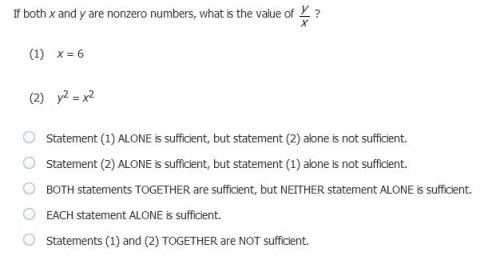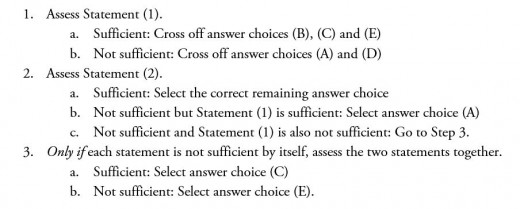Want To Ace GMAT Math? Understand This Unique Format
If you are preparing to take the GMAT, you may be worried about reviewing “all that math.” Thankfully, the level of math on the GMAT is almost the same as what you found on the SAT or ACT. But GMAT math is more challenging than the SAT or ACT for two reasons. First, the problems are longer and more complex. (In another hub I’ll discuss how to handle this complexity.)
The second reason is unique to the GMAT. It’s a test item format called Data Sufficienty (DS), and nearly half of the GMAT’s Quantitative Reasoning section (i.e. math) is presented in DS format. Getting used to this format, understanding the logic behind it, knowing what to look for when solving DS problems – I have found in my 10 years of GMAT prep teaching that DS logic is the most challenging part of GMAT exam for most test takers. This hub walks through DS logic and provides a strategy for approaching all DS problems. Additional hubs show how to use this strategy hand-in-hand with the strategy of applying actual numbers.
What Data Sufficiency Looks Like

The elements that you’ll see in every DS test item are:
- a question,
- two statements labeled (1) and (2), and
- five answer choices
One other frequently occurring element is additional information. It may be placed above the question (e.g. an equation or a geometric figure to which the question is applied) or included in the question, as it is in the sample item above (i.e. “If both x and y are nonzero numbers”). This information generally restricts the allowed values for variables in the problem.
One good thing that will help you to navigate DS problems is that the answer choices are the same in every DS problem: same wording, same sequence. So well before Test Day you’ll know exactly what each answer choice means without having to wade through the wording. (Notice that on the test, the answer choices are not labeled with (A), (B) etc. To keep my communication simple and clear, though, I’ll designate the answer choices with (A) through (E).) The answer choices can be boiled down to the sufficiency of statements (1) and (2):
Data Sufficiency Answer Choices
Answer Choice
| Statement (1)
| Statement (2)
| Statements (1) and (2)
|
|---|---|---|---|
(A)
| Sufficient
| Not sufficient
| NA
|
(B)
| Not sufficient
| Sufficient
| NA
|
(C)
| Not sufficient
| Not sufficient
| Sufficient
|
(D)
| Sufficient
| Sufficient
| NA
|
(E)
| Not sufficient
| Not sufficient
| Not sufficient
|
Sufficient Versus Not Sufficient
I hope by now that you’re asking yourself, “OK, but what does it mean to be sufficient?” A correct understanding of “sufficient” is absolutely key to DS logic. In fact, one of my first GMAT prep students arrived in my classroom completely baffled about his low GMAT math score; it truly didn’t reflect his math abilities. As it turned out, he needed nothing more than to correct his understanding of “sufficient” to drastically improve his score. Before my class, he thought that a statement was sufficient when he was able to get any answer to a DS question. This misunderstanding caused him to choose the wrong answer almost every time!
I’ve found that the easiest and safest way to phrase the meaning of “sufficient” on the GMAT is:
A sufficient statement allows one and only one answer
to the question.
So you can see where my student went wrong. If he got at least one answer to the question, he thought that the statement was sufficient. But it is precisely when you’ve gotten more than one answer to the question that you should declare a statement “not sufficient”!
Let me show you what “sufficient” and “not sufficient” look like with the sample problem above. When I apply Statement (1) to the question, it becomes
What is the value of y/6?
Since y could be any value except zero, there are certainly more than one possible answers to this question. So Statement (1) is not sufficient.
As I first consider Statement (2), it’s important to remember that Statement (1) does not apply. That is, x is not restricted to 6. So if y2 = x2, would there be one and only one value for y/x? Getting this problem correct depends on remembering that the square of a negative number is a positive number. When y2 = x2, it could be the case that y = x, but it could also be the case that y = -x. (For example, if y2 = x2 = 4, the y and x could both be 2, or y could be -2 while x is 2, or vice versa.) This means that there are two possible values for y/x: 1 and -1. So Statement (2) is not sufficient.
What just happened with Statement (2) suggests a general tactic that I employ on GMAT DS problems. To avoid declaring a statement sufficient when it is not, I assess each statement with the mindset that it is my job to find more than one answer to the question. Only after I’m reasonably well convinced that I won’t find a second answer do I decide that the statement is sufficient.
Back to our sample problem. If I had found either or both of the statements to be sufficient, at this point I would be finished with the problem. The answer would be (A), (B) or (D), depending on which statement/s is/are sufficient. But because each statement is not sufficient, I have one more step to perform so that I can choose between (C) and (E): I consider the two statements together.
In order to comply with both statements, x is limited to 6. But Statement (2) still allows y to be either 6 or -6, and so there are still two possible values for y/x, 1 and -1. This means that, even working together, the two statements are not sufficient, and this corresponds to answer choice (E).
Step by Step
Do you believe me now that the logic of DS is at least as important as the math? I’ve also found that the more complex the math, the easier it is to make mistakes with the logic. Test takers get so focused on solving for x (or whatever the math calls for) that they overlook some critical aspect of DS logic. To steer clear of such pitfalls, here is the step-by-step process I recommend. If you use it consistently, you’ll find it much easier to apply the correct logic even to more involved DS problems,

Apply Actual Numbers
Returning to the matter of math review: One more important piece of good news is that GMAT test takers can often bypass more challenging math concepts by applying actual numbers – a strategy that I explore in detail in a series of test prep hubs. The hubs are directed toward those preparing for the SAT, but they are completely relevant to standard multiple-choice problems on the GMAT. This same strategy can help to simplify DS problems, so some other hubs will explain how to apply actual numbers to this unique format.
Before you go any further with your GMAT preparations, try to commit the meaning of the five answer choices to memory. Then as you continue to practice, you’ll be drawing the information from your mind – just as you’ll want to do on Test Day.









